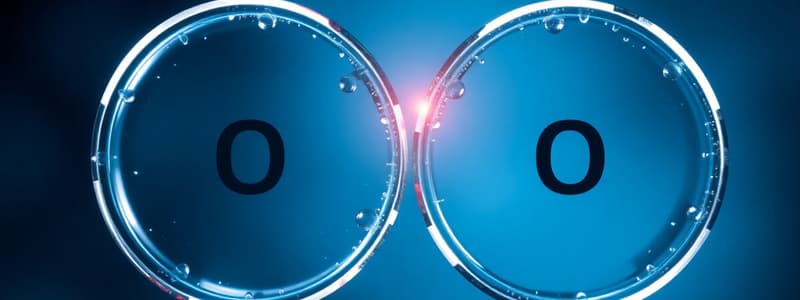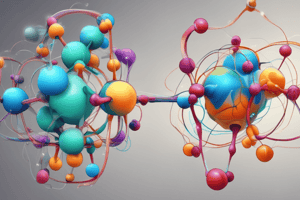Podcast
Questions and Answers
What occurs during the formation of an ionic bond?
What occurs during the formation of an ionic bond?
- Ions are formed but do not interact with each other.
- The outer shells of atoms remain unchanged.
- Electrons are shared between two metals.
- Electrons are transferred from one atom to another. (correct)
What type of structure is formed by ionic compounds?
What type of structure is formed by ionic compounds?
- Giant ionic lattice (correct)
- Molecular clusters
- Covalent network
- Amorphous solid
Which of the following ions has a negative charge?
Which of the following ions has a negative charge?
- SO42- (correct)
- Cl- (correct)
- Na+
- NH4+
How are covalent bonds primarily formed?
How are covalent bonds primarily formed?
What effect does a lone pair have on the bond angle between covalent bonds?
What effect does a lone pair have on the bond angle between covalent bonds?
What differentiates a dative bond from a standard covalent bond?
What differentiates a dative bond from a standard covalent bond?
Which compound is formed by sodium and chlorine?
Which compound is formed by sodium and chlorine?
What is the bond angle for a linear molecule?
What is the bond angle for a linear molecule?
In a triangular pyramid shape, how many lone pairs are present?
In a triangular pyramid shape, how many lone pairs are present?
What is the charge of an ammonium ion?
What is the charge of an ammonium ion?
How does electronegativity change across a period in the periodic table?
How does electronegativity change across a period in the periodic table?
In covalent bonding, how are multiple bonds represented?
In covalent bonding, how are multiple bonds represented?
What type of bond forms when two atoms with different electronegativities bond together?
What type of bond forms when two atoms with different electronegativities bond together?
What is the bond angle in a trigonal planar molecule?
What is the bond angle in a trigonal planar molecule?
What happens to the electronegativity of an atom as it moves down a group in the periodic table?
What happens to the electronegativity of an atom as it moves down a group in the periodic table?
What is the bond angle in a tetrahedral molecule?
What is the bond angle in a tetrahedral molecule?
What property makes mercury unique among metals at room temperature?
What property makes mercury unique among metals at room temperature?
Why do simple molecular substances generally have low melting and boiling points?
Why do simple molecular substances generally have low melting and boiling points?
What characteristic of diamond contributes to its hardness?
What characteristic of diamond contributes to its hardness?
How does the presence of lone pairs affect molecule shapes?
How does the presence of lone pairs affect molecule shapes?
Why is water considered unusual among simple molecular substances?
Why is water considered unusual among simple molecular substances?
What allows graphite to conduct electricity effectively?
What allows graphite to conduct electricity effectively?
What can change the bond angle in a molecule?
What can change the bond angle in a molecule?
What type of structure do macromolecular substances like diamond possess?
What type of structure do macromolecular substances like diamond possess?
What is the main characteristic of metallic bonding?
What is the main characteristic of metallic bonding?
What effect does a greater charge on the positive ions have in metallic bonding?
What effect does a greater charge on the positive ions have in metallic bonding?
How do the physical properties of ionic substances compare to those of metallic substances?
How do the physical properties of ionic substances compare to those of metallic substances?
What happens to ionic substances when they are molten or in solution?
What happens to ionic substances when they are molten or in solution?
Which statement is true about metallic substance conductivity?
Which statement is true about metallic substance conductivity?
Which characteristic of ionic substances contributes to their high melting and boiling points?
Which characteristic of ionic substances contributes to their high melting and boiling points?
What type of crystal structures have different physical properties based on their bonding?
What type of crystal structures have different physical properties based on their bonding?
What factor impacts the strength of metallic bonds in terms of ionic size?
What factor impacts the strength of metallic bonds in terms of ionic size?
What type of intermolecular force is the weakest?
What type of intermolecular force is the weakest?
Which type of molecule experiences stronger van der Waals forces?
Which type of molecule experiences stronger van der Waals forces?
What is necessary for hydrogen bonding to occur?
What is necessary for hydrogen bonding to occur?
What effect does hydrogen bonding have on the physical properties of substances?
What effect does hydrogen bonding have on the physical properties of substances?
Which regions in a polar molecule attract each other through a permanent dipole?
Which regions in a polar molecule attract each other through a permanent dipole?
How does molecular weight (Mr) affect van der Waals forces?
How does molecular weight (Mr) affect van der Waals forces?
Which of the following molecules is most likely to exhibit hydrogen bonding?
Which of the following molecules is most likely to exhibit hydrogen bonding?
How can a molecule with an induced dipole generate attractions?
How can a molecule with an induced dipole generate attractions?
Flashcards are hidden until you start studying
Study Notes
Ionic Bonding
- Occurs between a metal and a non-metal
- Electrons are transferred from the metal to the non-metal
- Creates charged particles called ions
- Oppositely charged ions attract through electrostatic forces to form a giant ionic lattice
- Common compound ions include sulfate, hydroxide, nitrate, carbonate and ammonium
Covalent and Dative Bonding
- Covalent bonds form between two non-metals
- Electrons are shared between the two outer shells
- Multiple electron pairs can be shared, which produces multiple covalent bonds
- Dative bonds form when both electrons in the shared pair are supplied from a single atom
- Once a dative bond has formed, it is a standard covalent bond and reacts the same way
Metallic Bonding
- Metallic bonding consists of a lattice of positively charged ions surrounded by a sea of delocalised electrons
- This produces a very strong electrostatic force of attraction between these oppositely charged particles
- The greater the charge on the positive ion, the stronger the attraction (more electrons are released)
- Larger ions produce a weaker attraction due to their greater atomic radius
Bonding and Physical Properties
- Physical properties include boiling point, melting point, solubility and conductivity
- They are different depending on the type of bonding and crystal structure
- Crystal structures include ionic, metallic, simple molecular and macromolecular
Crystal Structures
Ionic
- Ionic substances have high melting and boiling points
- This is because the electrostatic forces holding the ionic lattice together are strong and require a lot of energy to overcome
- When molten or in solution, ionic substances can conduct electricity because the ions separate and are no longer held in a lattice
- Ionic substances are often brittle materials
Metallic
- Substances with metallic structure are often good conductors
- Metals are also malleable as the layers of positive ions are able to slide over one another
- The delocalised electrons prevent fragmentation as they can move around the lattice
- Metallic substances have high melting points and are nearly always solid at room temperature
Simple Molecular
- Simple molecular structures consist of covalently bonded molecules held together with weak van der waals forces
- These are a type of intermolecular force that acts between molecules
- Simple molecular substances have low melting and boiling points
- Simple molecular substances are very poor conductors as their structure contains no charged particles
Macromolecular
- Macromolecular structures are covalently bonded into a giant lattice structure
- Each atom has multiple covalent bonds, which are very strong, giving the substance a very high melting point
- The strength of the covalent lattice makes macromolecular substances rigid
Shapes of Molecules
- The shape of a molecule is determined by the number of electron pairs around the central atom
- Each electron pair naturally repels each other so that the largest bond angle possible exists between the covalent bonds
- Any lone pairs present around the central atom provide additional repulsive forces, which changes the bond angle
- Lone pairs around the central atom reduce the bond angle by 2.5 degrees
Bond Polarity
- The negative charge around a covalent bond is not evenly spread around the orbitals of the bonded atoms
- Every atom has electronegativity, which is its power to attract negative charge towards itself within a covalent bond
- Electronegativity increases along a period and decreases down a group
- If the two atoms that are bonded have different electronegativities, a polar bond forms
- The more electronegative atom draws more of the negative charge towards itself, producing a ∂- region and a ∂+ region
Intermolecular Forces
- There are three main types of intermolecular forces
- Each one differs in strength and what it acts between
Van Der Waals Forces
- This is the weakest type of intermolecular force
- It acts as an induced dipole between molecules
- The strength of van der waals forces varies depending on the Mr of the molecule and its shape
- The larger the Mr of a molecule, the stronger the intermolecular forces
Permanent Dipole
- This type of intermolecular force acts between molecules with a polar bond
- The ∂+ and ∂- regions attract each other and hold the molecules together in a lattice like structure
- This force is stronger than Van der Waals forces
Hydrogen Bonding
- Hydrogen bonds only form between hydrogen and the three most electronegative atoms: nitrogen, oxygen and fluorine
- The lone pair on these atoms forms a bond with a hydrogen atom from another molecule
- It is the strongest type of intermolecular force
- Molecules held together with hydrogen bonds have much higher melting and boiling points compared to similar molecules without hydrogen bonding
Studying That Suits You
Use AI to generate personalized quizzes and flashcards to suit your learning preferences.




